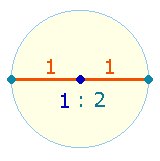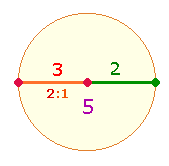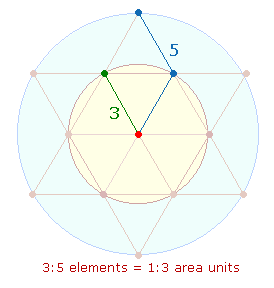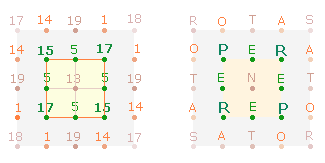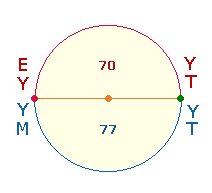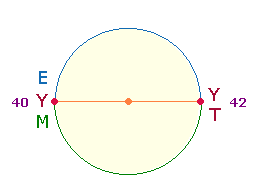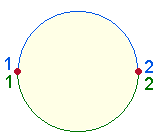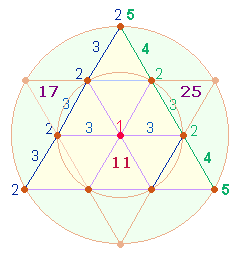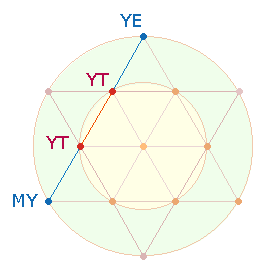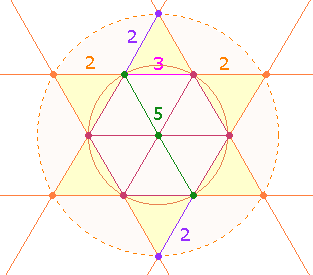back
Alphabets;
factoral values
Shakespeare's Epitaph
E. Gematric Meaning of the 4 Y-Words
F. Values of y-words combined with
SATOR Square
G. Greek Y-words in the Angel's Annunciation Speech
A review on this
topic five years later may serve as a suitable introduction
|
6 |
GOOD FREND FOR IESVS SAKE FORBEARE |
|
6 |
TO DIGG THE DVST ENCLOASED HEARE. |
|
8 |
BLESTE BE YE MAN YT SPARES THES STONES |
|
8 |
AND CVRST BE HE
YT MOVES MY BONES. |
1. It is astonishing that
the letter Y occurs in 4 two-letter words. Each pair is separated by one word,
which gives them a concentric symmetry: YE and MY take the positions 15 and 27, the two YT the positions 17 and 25, which make up 42 for one pair. The
total sum of the 4 positions is 84 = 4*21.
Two more things are
remarkable: YT occurs twice as the central word pair, and the first word starts, the
last ends with Y.
2.
The four words have the following numeric values (NV):
|
|
YE |
YT |
YT |
MY |
sm. |
|
NV |
28 |
42 |
42 |
35 |
147 |
|
147 = 7*21 |
|||||
Remarkably, all four NV are divisible by 7.
If the word positions
are symmetrical, we must suppose so for the NV as well: 28+35 = 63;
42+42 = 84; 63:84 = 21*(3:4).
We must assume that
Shakespeare wanted to see the sum of word positions 84 and the gematric sum (NS) 147 related to each other.
But what relation did he think of?
I think Shakespeare
wanted to point to a principal problem. The two values essentially imply two
different aspects: The number 84 can be understood as independent of 147 or part of it. If the
two numbers are thought independent, their ratio is 21*(4:7). Indeed, their context
is different.
If we were to define
which number is functionally assigned to which, we would say the sum of
positions to the gematric sum rather than the other way round. We would then
ask: By what quantity or ratio does the bigger number exceed the smaller
number? We would then say: by 3 parts out of 7. We might define the
whole quantity from the point of division as 4:3.
We may now go on to imagine
that the sum of positions is a real part of the gematric whole comparable to
the whole length of a violin string that is pressed down at a certain ratio to
produce a certain interval. By convention the part of the string that is not
struck is related to the whole length, not just to the part that is struck.
Thus the basic tone of a string sounds one octave higher if it is pressed down
exactly in the middle. The ratio one says is 1:2, one part out of two, not 1:1, one half and another half.
3.
But obviously both ratios are valid. A geometrical model
that corresponds to the octave situation on the violin string is the diameter
of a circle. The two halves of the violing string (1:1) are the two radial
lines. The 1:2 ratio convention consists here of the central point and two
symmetrical points on the circle line:
|
|
As two-digit numbers
these two ratios add up to 23, the numerical value of Y according to
Shakespeare's alphabet of 24 letters. Shakespeare has illustrated this by the
central word pair YT, whose text positions are 17+25 = 42 and NS is 42+42 = 84.
4. The radius of a circle
is defined as a measure or line delimited by two points. So one radius consists
of 3 elements. If only one central point is admitted, the second radius
consists of 2 remaining elements of the diameter.
Shakespeare has
represented this relationship by the first and fourth word pairs YE and MY, whose NS is 28+35 = 63, while the sum of their text positions is again 42. If 42 is thought as the
division point of the whole 63, the ratio is 21*(2:1), if it is thought
independent of 63 or part of it as the whole, then it is 21*(2:3):
|
|
We may call the first ratio as internal,the second as external. If we add the numbers
of each ratio and consider the results as ratio numbers again, we get the external ratio 3:5,
which however points to a further development of the plain circle: to the two
concentric circles of the tetraktys star. In this context the ratio 3:5 refers to the radial
elements of the smaller and the bigger circle:
|
|
The sense of adding the internal
and external ratio numbers is concentricity. It applies to circles
but especially to squares. Thus Shakespeare's 4 textpositions
totalling 84 just stands for a basic square of four sides each
consisting of 2 points delimiting 1 line. However, if the square is to have a central
point, the ratio 2:1 refers to points only. The SATOR Square offers a
perfect example for this: The NV of the inner square with 8 letters is 84. The numbers 15 and 17 for P and R are also text
positions in Shakespeare's epitaph:
|
|
The NS+FS of OPERA is 52+40 = 92 = 4*23, which stands either for 2 lines + 3 points of a smaller
square or for 2 even points (2, 4) and 3 uneven points (1,3,5).
There is a successive
pattern for concentric squares with a central point: Each bigger square
contains 4 elements more for each side.
5. If we apply the external ratio mode, we can
take either lines or points as part of the whole. This would mean for the
diameter the ratios 2:5 and 3:5 with the ratio numbers summed up to 15.
The same goes for the 3 lines and 4 points of one
tetractys side: 3:7 and 4:7, as added numbers resulting in 10+11 = 21. The numbers 10
and 11 point to the double rhombus with 10 lines and 7
points + 4 triangles.
6. The tetraktys frame is
a special model of external ratio: Each side of the triangle consists of 4 points,
this is 12 points for three sides. If one adds the 3*3 = 9 lines, the result is
the inversion number 21. These two numbers
define the principle of measure geometrically: 1 line delimited by 2 points.
The
external ratio (ER) so complies with the formula ER = a:(a+b).
7. The problem of internal and external ratios refers
especially to the relation between the factoral value of a number and the whole
of the numerical value. In this respect the name VESTA seems to be the main
model. Like YE and MY the numerical value is 63 and the the factoral
value 42 comparable to the sum of the text positions.
8. The fact that the YE starts with Y and MY ends with it, suggests
that Shakespeare thought of the words to be arranged in a circle:
|
|
|
The first circle
defines values separately for each half of the arc, the
second removes the principle of double values.
There is a ratio of the left and
right values if the factoral values are included:
|
LEFT
POINT |
RIGHT
POINT |
|||||||||
|
4 letters |
3 letters |
|
4 letters |
2 letters |
|
|||||
|
NV |
FV |
NV |
FV |
|
NV |
FV |
NV |
FV |
|
|
|
63 |
58 |
40 |
35 |
196 |
84 |
84 |
42 |
42 |
252 |
|
|
196:252 =
28*(7:9) |
||||||||||
Perhaps Shakespeare's knowledge of
Greek was sufficient to understand the three letters MYE as an intransitiv
imperative meaning (circle, may you) CLOSE or possibly as a wish
to himself Shut your eyes (for eternal rest).
In English language tradition the
letter Y was thought to be composed of V/U and I so that it came to be
called UI and pronounced [wai]. If you read MY backward, Shakespeare
might have associated Y with W and regarded M as the last letter of WILLIAM. The gematric values
for the two letters are in consistency with their inverse shape 21 and 12. The two numbers can
indicate the two halves of a circle divided by the diameter:
|
|
We can now read backward TYE WILLIAM with the inverse
values 47+74 = 121. The sense might be: Bind me
to yourself, God. But this is just an idea.
9.
The position numbers 17 and 25 suggest that
Shakespeare knew about two ways of numbering the points and lines of the
tetraktys frame:
|
|
The extension elements
either take the same numbers as the hexagon elements or they continue with 4 and 5. If one sums up the 7 unnumbered elements of
a triangular side and the numbered sums 17 and 25, the result is 49, exactly the total of
tetraktys elements. Multiplied by 3, the result is 147, the NS of the 4 Y-words.
The 4 points of the
numbering with the sum 17 are marked with 2 and so are possible places
for the 2-letter Y-words:
|
|
If the numbers of one
triangular sides are counted, the corner points are
twice affected. So the real sum of the 3*17-count is 3*15 = 45. Here the concentric process of extension from the 5 elements of the hexagon diameter to the 9 diametrical elements
of the tetraktys star becomes evident: If one combines the numbers 2 and 3 for the points and
lines to the 2-digit number 23, the remaining sum to 45 is 22. This may have been a main motive for Shakespeare to make
a double calculation with numeric value 23 and 22 for the letter Y.
10. The 17-count divides up into 8 for the points and 9 for the lines. These
two numbers play an important role. The number 17 is confirmed by the NS+FS of the 23-count: As 12 for M is the only non-prime
number with the factoral value 7 – 5 less than the numeric value, the NS+FS of the Y-words is 289 = 17*17.
The NS+FS of the 22-count is 44 less than the result
of the 23-count: 289-44 = 245.
The balance of numeric and
factoral values produces the following result:
|
|
|
|
sm. |
|
FV |
|
NS+FS |
289 |
245 |
534 |
6*89 |
94 |
|
FV |
34 |
19 |
53 |
|
53 |
|
sm. |
|
|
|
|
147 |
The balancing calculation
of the two numbers 289 and 245 leads back to the original NS 147.
11.
In order to obtain the shape of the tetractys star, one
has to prolong the 6 segment lines of the hexagon to both sides, until they
intersect. In this way a close relation between the 7 frame elements of the
tetraktys and the 9 diametrical elements of the double-rhombus is
established:
|
|
The pattern of frame
elements 232 as a 3-digit number can be divided by 8 and 29. The result 29 is obtained if the 9 diametrical elements
are numbered from the centre with the numbers 1 to 5:
|
|
Shakespeare's double counting
of 23 and 22 of the 4 Y-words leads to the NS 147+143 = 290. This result conincides with the FS of the three inversion
numbers 232, 223, 322:
|
NV |
223 |
232 |
322 |
777 |
|
FV |
223 |
35 |
32 |
290 |
There may
be another reason for the sum 290: The letter Y was thought to be
composed of the letters V and I whose gematric values are 20+9 = 29.
12.
The NS 143 of the 22-count is 13*11, this means that the
ratio between the NV of the 4 Y and the other 4 letters (E,T,T,M) is 11*(8:5).
The FS is 102, which reminds of the NS of 8 different letters of
the SATOR-Square PENS|ATOR. In fact, the two halves have the FS 50+52:
|
YE |
YT |
YT |
MY |
|
|
18 |
32 |
32 |
20 |
|
|
50 |
52 |
102 |
||
The NS+FS of both counts are:
|
|
YE |
YT |
YT |
MY |
|
|
23 |
56 |
84 |
84 |
65 |
289 |
|
22 |
45 |
73 |
73 |
54 |
245 |
|
|
101 |
157 |
157 |
119 |
534 |
|
|
258 |
276 |
|
||
|
258:276 = 6*(43:46) |
|||||
Written: January 2009
